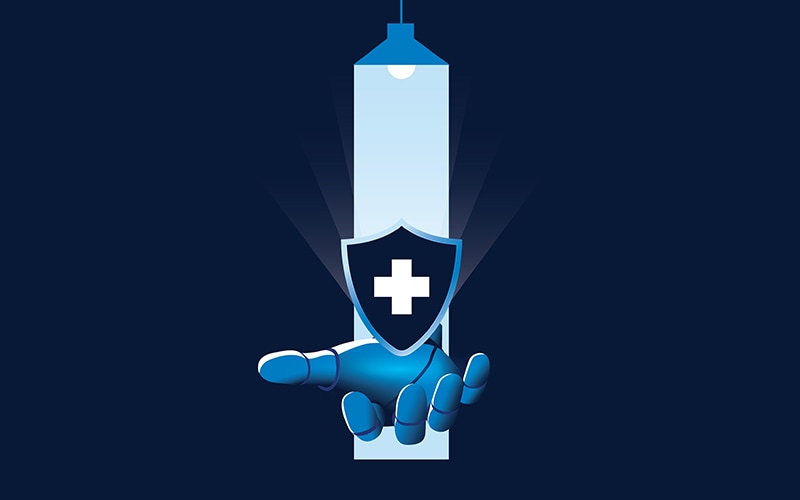Delivering the right treatment to the right patient at the right time continues to be the holy grail for medical researchers. Even Hippocrates, history’s most famous physician, believed people’s individual needs should be factored into their treatment: “Give different ones [liquid medicines] to different patients, for the sweet ones do not benefit everyone, nor do the astringent ones, nor are all the patients able to drink the same things.”1
Treatments are conventionally developed for the average person because of the costs and complexity of treating each patient individually. But this one-size-fits-all approach has not always been successful. In fact, imprecise medications account for around 30% of hospital admissions every year.2
Things are changing, though. The health care industry is exploring more precise treatments, targeted drug discovery and patient care. This “precision medicine” approach classifies individuals into subpopulations3 based on their sensitivity to a particular disease and formulates treatments taking their lifestyle, environment and individual genetic variability into account (Figure 1). Using analytics, patterns are spotted, helping enhance the effectiveness of particular treatments.
Though the idea of precision medicine has been around for some time, it has been largely limited to oncology because of the unavailability of data, limited technology and high costs involved in genetic testing. However, advancements in data collection, technology and genetics are making the broader use of precision medicine techniques possible.
A decade ago, it took 13 years and cost $1 billion to sequence a genome. Today, it takes just a few hours to sequence a genome and costs around $1,500.4 Also, there has been a tremendous proliferation of electronic health records in the last few years. A paper by Stanford University School of Medicine estimates that around 2,314 exabytes of health care data will be produced by 2020 at an annual growth rate of 48%.5 Technological advancements are also making it easier to integrate and analyze these large troves of data.
With the potential to better predict, detect, treat and prevent a wide range of diseases, precision medicine will transform how the health care industry works.
Precision medicine will revolutionize the health care industry by preventing various diseases through better predictions, detections and treatments
Yet it is technology companies and not just health care providers that will drive this transformation. Digital devices and imaging help in data collection. Digital platforms will help tie the data together. Analytics and artificial intelligence will be used to build computational models for recommendations on treatment and prevention.
Figure 1. The precision medicine life cycle covers collection, processing, sharing and monitoring of health data.
Source: Infosys
Diagnostics, pharma companies and doctors also need to become technologically proficient to assimilate and analyze the data-based models of genomes and biomarkers to formulate the right treatments.
Aside from the technology, health care stakeholders also need to collaborate to create business models that support the delivery of precision medicine at an affordable price. While costs are falling, the techniques are still in their early stage of evolution, and precision medicine is still an expensive route. Getting the price down is crucial to build a sustainable precision medicine ecosystem.
Challenges in scaling precision medicine
There is no doubt about the potential that precision medicine holds. But like any other developing field, it has many hurdles to cross before it becomes mainstream and commercially viable. Some of the most critical issues that challenge precision medicine today are higher costs, identifying and modeling the right data, regulations and building the right skill sets.
Higher costs
Precision medicine involves testing patients to understand various biological markers. Such tests are still expensive despite decreasing prices. This imposes a lot of financial burden on patients since they are not covered by insurance in most cases. So even if people know that such tests are valuable, it is not possible for most of them to opt for such tests.
Another area of concern is the high cost of storing and managing large amounts of data. Implementing advanced technologies to derive insights from this data is also expensive. Precision medicine also involves researching and developing precision drugs that target specific genetic characteristics. The consensus is that these techniques will be highly expensive for the foreseeable future.6
Building expertise
Precision medicine involves building analytical models based on genetic and other biomarkers. Therefore, as precision medicine becomes a part of regular health care, health care providers have to learn about biochemistry and genetics to understand the results. They will also have to learn to interpret the data and make the right diagnosis based on the insights from the data. In effect, doctors will have to upskill themselves in technology along with the already strenuous training they are required to undergo in order to practice medicine.
Getting good data
Precision medicine involves creating computational models based on clinical and research data to predict, diagnose and treat diseases.7 Accurate models can be built only if there are a large number of accurate data points. Collecting the right information from patients at different touch points and building a large database of consistent data and metadata can be arduous. Also, data from genomics alone is not enough. Data from other types of omics (environmental, lifestyle based, etc.) also needs to be collected. An important measure is to ensure that data is collected from a diverse population. Otherwise, biases can creep in.
Another challenge is converging the large troves of data that exist among patients, health care providers, pharmaceuticals, diagnostic companies and payers into a single body of knowledge. Firms’ hesitation to share data with others is another barrier in building an effective database for precision medicine.
Legal and ethical issues
Precision medicine requires patients to share highly personal medical data. Companies that use this data must prioritize the privacy and confidentiality of this data. People also need to know the risks associated with sharing their data, how their data is going to be used and who has access to their data. In the backdrop of multiple data security breaches, many are not confident about sharing their data with medical practitioners.
Making precision medicine work
As with any young, growing field, the rules, ecosystem and models are evolving. Several things have to happen before precision medicine can be a scalable and sustainable model for the pharmaceutical and health care industries. Standards must be established and platforms created that bring different stakeholders from across industries to work together around robust commercial and business models.
Establishing standards
Data is the bedrock of precision medicine — collected from different people, through different sources, via different channels and from different devices. But this data is structured differently. For it to be of value, standardization needs to occur. But the challenge goes beyond just sharing a set of protocols.
With an increase in the number of real-time health monitoring devices, the number of different formats that capture data has also increased — and is ever growing and changing. While some might be certified by the right authorities, there is no guarantee that all of them measure the right data. It is important to ensure that only data from certified devices enters the electronic records used for precision medicine. Corrupt or incorrect data can lead to incorrect results that can affect data models, in turn affecting a larger set of patients.
Today, data is organized based on data collectors such as health care system providers or labs. For the data to be accessible across all health care providers, this has to change to a patient-based record-keeping system. When it comes to genetic diseases, family history is important, and patient-based records can help identify similar genetic structures in other members of the family.
The combination of continuous data-backed insights and community data learnings will help pinpoint the causes of diseases and prevent them
The ultimate aim of precision medicine is to have a digital ecosystem for each patient into which data is continuously fed. The insights continuously derived from this data, combined with learnings from community data, will help target and treat the exact cause of illness and prevent diseases.
Robust business models
Precision medicine combines many realms: digital technologies, personal data, medical expertise, biochemistry and health care provision. The number of stakeholders involved (Figure 2) can make creating even the simplest of solutions quite overwhelming. Thankfully, each of these stakeholder groups has already begun the journey toward embracing their part in precision medicine.
Academia has been active in identifying technological and engineering solutions and connecting them with clinical research breakthroughs that can help precision medicine. For instance, five campuses of the University of California have come together for research on big data analytics and precision medicine to understand and improve cancer treatments.3
Technology companies are developing artificial intelligence tools that can help doctors identify the right treatments and medicines and predict potential health problems. They are also developing digital platforms to integrate data and enable the development of innovative solutions for precision medicine.
With growth in precision medicine, pharmaceuticals will have to be quick to predict treatments and create customized medicines at low costs. This will require a strong technology infrastructure. Pharma companies are equipping themselves to grow in this changing environment. For example, Roche, a pharma company, acquired Flatiron, a health care technology company, for $1.9 billion to accelerate the development of breakthrough medicines.8
Governments also see the growing need for precision medicine and are taking initiatives in this field. For example, the U.S. government launched the Precision Medicine Initiative in 2015, aimed at transforming the understanding of patients, diseases and treatments through comprehensive analysis of data collected from 1 million volunteers across the U.S. Several countries, such as Japan and Iceland, are also building population databases of medical records.
Yet, while all these players are actively involved, they are working largely in silos. For precision medicine to be commercially sustainable, robust business models will need to evolve. The key here will be to bring these stakeholders together in a way in which each achieves their strategic objectives.
Pharma companies will have to collaborate with health care providers and technology companies to customize their drugs according to precise treatments. Health care providers will have to work with technology companies to derive the right insights from data. Government will have to incentivize the early players to boost participation.
To create cost-effective precision medicine, pharma companies, technology companies, health care providers and payers will have to work together to deliberate on business models that can help create a sustainable system.
Figure 2. Stakeholders are actively contributing to the growth of precision medicine.
Source: Infosys
Precision platforms
Effective digital platforms could be the answer to support the collaboration of all these different stakeholders. Digital platforms can help bring the stakeholders and data together by providing the infrastructure for different stakeholders to develop innovative solutions for precision medicine using the underlying data. They can boost collaborations between different players by providing a common platform to share their information. And they can also act as a single body of knowledge by collating patient data from different players in the industry.
To succeed, a platform will need to be competent at managing large volumes of data, as well as enabling the tools required to derive actionable insights from that data. Finally, it must also publish and receive data and insights in a manner that enables easy integration and interoperability.
All this is easier said than done, of course. Yet there are real opportunities to be had for those that invest early in building such platforms. Health data and personalized care are concepts that will not subside and can provide benefits for insurers, health providers and governments by reducing the occurrence of disease and the cost to respond to it. Those with commercial interests at the intersection of data, diagnostics and medical technologies and treatments are best placed to act — but they must act together.
References
- “Precision medicine – moving away from one-size-fits-all”, EDHIC, 2018, https://www.ehidc.org/sites/default/files/resources/files/precision%20medicine.pdf
- “Drug Industry Bets Big On Precision Medicine: Five Trends Shaping Care Delivery”, Forbes, March 2017, https://www.forbes.com/sites/reenitadas/2017/03/08/drug-development-industry-bets-big-on-precision-medicine-5-top-trends-shaping-future-care-delivery/#6425ae855d3a
- “What Are Precision Medicine and Personalized Medicine?”, Health IT Analytics, January 2018, https://healthitanalytics.com/features/what-are-precision-medicine-and-personalized-medicine
- “Precision Medicine: Changing the way we think about health care”, NCBI, November 2018, https://www.ncbi.nlm.nih.gov/pmc/articles/PMC6251254/
- Harnessing the Power of Data in Health: Stanford Medicine 2017 Health Trends Report, June 2017, https://med.stanford.edu/school/leadership/dean/healthtrends.html
- Precision medicine: overcoming cost challenges, PharmaTimes, November 2018, http://www.pharmatimes.com/magazine/2018/november_2018/precision_medicine_overcoming_cost_challenges
- “Problems, challenges and promises: perspectives on precision medicine”, Oxford Academic, May 2016, https://academic.oup.com/bib/article/17/3/494/1744384#35638147
- “Roche to acquire Flatiron Health to accelerate industry”, Roche.com, February 2018, https://www.roche.com/media/releases/med-cor-2018-02-15.htm






